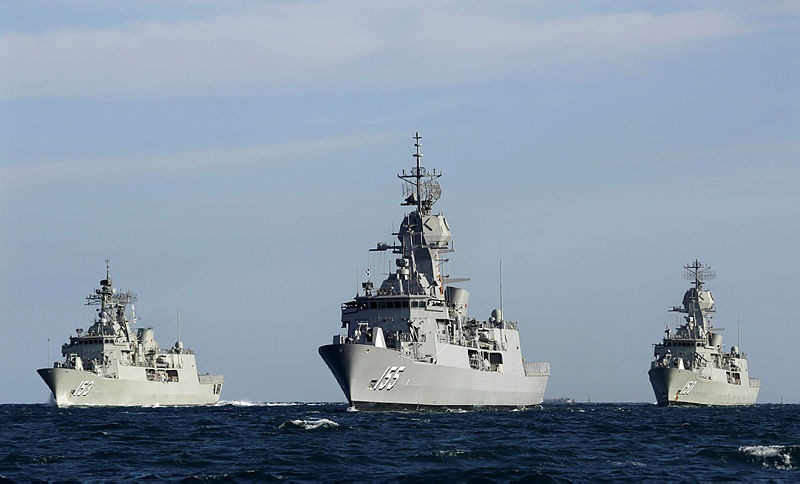Form follows function
Posted By
Alastair Cooper
on April 5, 2016 @ 11:00

In ‘The expanding of the shrew’ Andrew Davies offered up an interesting view of warship nomenclature and why the future frigate should be classified as a cruiser because the displacement for the vessel could be around 6,000 tonnes. That view is mistaken; the future frigates are accurately described as such and to do anything else would be misleading.
Why? Simply because the terms used to classify warships are a description of function more than form.
The modern usage of the term ‘frigate’ dates from WWI, when it was used to describe a warship primarily used for convoy escort—a task which required general maritime warfare functions and anti-submarine warfare capabilities in particular. Leaving to one side the USN’s excursion with the term up to the 1970s, the function of a frigate has been consistent for the last 100 years.
(If you want some truly elastic uses of warship nomenclature, have a look at the Japanese Maritime Self-Defence Force’s most recent helicopter destroyers. Or for those with a more historical bent, try the Royal Navy’s through deck cruisers in the 1970s. If only deception were such a simple activity!)
There are two other common contemporary terms used to describe large surface warships; cruisers and destroyers. The destroyer dates from just prior to the First World War and is a shortened version of a torpedo-boat destroyer. A destroyer also has general maritime warfare capabilities, weighted toward surface and air warfare. A cruiser is similar, but with the addition of command and control capabilities that enable effective command of other warships in at least one warfare discipline. It isn’t that frigates and destroyers are incapable of command and control functions—all warships possess them in varying degrees—but a cruiser would be expected to be able to perform the command function in a large carrier or amphibious task force. Yes, a destroyer or frigate could do it, but they would be much less likely to have the equipment (communications in particular) and the people to be as effective as a cruiser.
The terms cruiser, destroyer and frigate thus describe the functions of the warships. While some general assumptions can be made about the form required for such functions, there’s no prescriptive relationship. Certainly displacement or any other physical measurement isn’t a definitive guide to the way a warship is classified.
The form a warship takes to achieve its function is a much more dynamic subject. Warships do indeed evolve over time as technology, threats and opportunities change. It would be strange if a frigate today was the same as one from 50 or 100 years ago. Such evolution isn’t constrained to warships: infantry, tanks, aircraft, industrial equipment, missiles, computers, cars, phones and innumerable other organisations and devices have also evolved in their form, while their function has been more stable.
A significant question for the future frigate is how they’ll incorporate some of the more likely evolutions in warfare over the next decades, such as expanded uses of unmanned vehicles and directed‑energy and cyber weapons. It’s here some of the most significant benefits of Australia’s continuous ship-building program will be found because it involves a continuous design effort. The first batch of future frigates will likely be similar to warships already in service, but future batches will incorporate more advanced weapons and systems as they become available.
Warship and submarine design are complex activities, with numerous constraints ranging from financial to practical and technological. There’s an unhappy history in Australia of focussing on warship displacement as a proxy for cost. It would be a shame if Australia’s future frigate design was constrained by a dogmatic view of what the displacement of a frigate should be. Aircraft aren’t classified by their wingspan, nor should ships be classified by displacement.
Understanding the difference between form and function enables us to understand why a frigate designed to operate for one navy in the North Sea may well be different to one designed to operate for another navy in the Indian or Pacific Oceans. So two warships of quite different size and capability might still be classified as frigates. But then, I’m sure Andrew isn’t calling for a one size fits all approach.
In one sense the warship nomenclature is an arcane subject, not likely to be of interest to many ASPI Strategist readers. But I’m guessing that Andrew’s enduring concern over the value for money might be at the heart of the matter. Cost is absolutely an issue worthy of close attention, because money is never unlimited and choices within and between capabilities must be made. Costs must be understood in terms of the value of the capabilities being purchased; we should have a value-driven approach to acquisition and force structure. I think Australia will need and derive great value from its surface warships, from its submarines, from its F-35s and from its future land forces.
Alastair Cooper is a public servant in the Attorney-General’s Department and an active Royal Australian Navy Reservist serving in Navy Strategic Command. The views expressed here are his own.
Article printed from The Strategist: https://www.aspistrategist.org.au
URL to article: https://www.aspistrategist.org.au/form-follows-function/
[1] The expanding of the shrew’: http://www.aspistrategist.org.au/the-expanding-of-the-shrew/
[2] most recent helicopter destroyers: http://thediplomat.com/2015/03/after-the-izumo-whats-next-for-japans-navy/
[3] through deck cruisers: http://www.military-today.com/navy/invincible_class.htm
 Print This Post
Print This Post